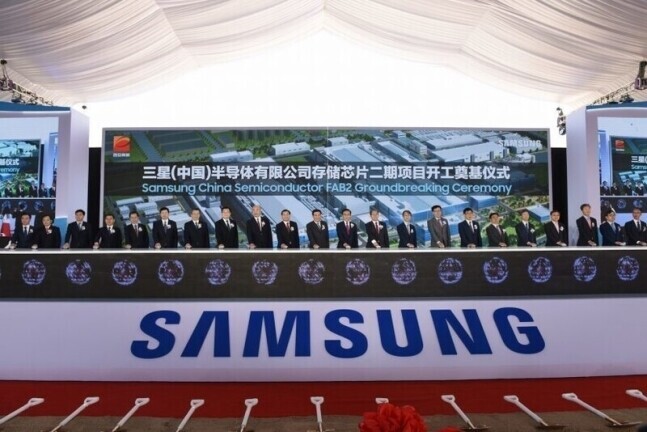hankyoreh
Links to other country sites 다른 나라 사이트 링크
Is importing US equipment, investing in China about to get harder for Korean chipmakers?

Attention is mounting after a US government official revealed that South Korean semiconductor companies in China may face difficulties in importing semiconductor equipment in the future. These comments precede the start of the subsidy application process for Samsung Economics and SK Hynix on Tuesday, local time.
The news appears to suggest that Korean companies will face pressure to limit production in China in addition to that to invest in the US. For South Korean companies, geopolitical uncertainties are adding to their already sluggish earnings amid a weak semiconductor market.
Alan Estevez, the US Commerce Department’s undersecretary for industry and security, replied to a question inquiring what would happen after the one-year reprieve from US export restrictions on memory chipmakers in China by stating that what will be “likely” is “a cap on the levels that they can grow to in China.” The implication is that the advanced processes in Chinese semiconductor factories could be halted.
In October 2022, the US Department of Commerce required companies in China to obtain a license to sell equipment that produces D-RAM at 18 nanometers (nm, one-billionth of a meter) or smaller and NAND flash at 128 gigabits or larger. However, Samsung and SK Hynix were given a one-year grace period. Samsung and SK Hynix manufacture DRAM and NAND flash in Xi’an and Wuxi/Dalian, respectively. If they are unable to import equipment from the likes of US companies Lam Research and AMD, they may not be able to switch to more advanced processes and lose their competitive edge.
Estevez left open the possibility of extending the grace period, saying that they were working with South Korean semiconductor manufacturers
“We work with them to ensure that we aren't going to harm our allies' companies,” said Estevez. “At the same time, we're going to impede the Chinese capability of building capabilities that are going to threaten us collectively,
A semiconductor industry official, who wished to remain anonymous, shared, “If the US deemed that there would be a clear benefit from the sanctions, it would be possible, but there is nothing for the US to gain by extending the waiver to our companies when we still have to rely on imports for memory semiconductors.” Rather than actualizing sanctions on South Korean factories in China, the official said, this method is more a way to encourage further US investment.
In addition, the US government will begin accepting applications for subsidies from companies building semiconductor production facilities in the US starting Tuesday, following the CHIPS and Science Act. Those companies will be provided with detailed standards (guardrails) to limit their investment expansion in China for the next 10 years.
In the meantime, Korean companies have been paying close attention to the content of the guardrails. While there are restrictions on system semiconductors (older generations greater than 28 nm), there are no restrictions on memory semiconductors, which are the main product of Korean companies. If advanced processes are included in the restrictions, Korean companies may be forced to choose between the US and China.
Domestic companies have no choice but to hope that the government responds with tact.
“It isn’t just about the economy,” one company official stated. “It has to do with politics and national security. Businesses have no choice but to turn to and rely on the government.”
By Lee Jeong-hun, staff reporter
Please direct questions or comments to [english@hani.co.kr]

Editorial・opinion
![[Guest essay] Preventing Korean Peninsula from becoming front line of new cold war [Guest essay] Preventing Korean Peninsula from becoming front line of new cold war](https://flexible.img.hani.co.kr/flexible/normal/500/300/imgdb/original/2024/0507/7217150679227807.jpg) [Guest essay] Preventing Korean Peninsula from becoming front line of new cold war
[Guest essay] Preventing Korean Peninsula from becoming front line of new cold war![[Column] The state is back — but is it in business? [Column] The state is back — but is it in business?](https://flexible.img.hani.co.kr/flexible/normal/500/300/imgdb/original/2024/0506/8217149564092725.jpg) [Column] The state is back — but is it in business?
[Column] The state is back — but is it in business?- [Column] Life on our Trisolaris
- [Editorial] Penalties for airing allegations against Korea’s first lady endanger free press
- [Editorial] Yoon must halt procurement of SM-3 interceptor missiles
- [Guest essay] Maybe Korea’s rapid population decline is an opportunity, not a crisis
- [Column] Can Yoon steer diplomacy with Russia, China back on track?
- [Column] Season 2 of special prosecutor probe may be coming to Korea soon
- [Column] Park Geun-hye déjà vu in Yoon Suk-yeol
- [Editorial] New weight of N. Korea’s nuclear threats makes dialogue all the more urgent
Most viewed articles
- 1Yoon’s broken-compass diplomacy is steering Korea into serving US, Japanese interests
- 2[Guest essay] Preventing Korean Peninsula from becoming front line of new cold war
- 3[Column] Why Korea’s hard right is fated to lose
- 460% of young Koreans see no need to have kids after marriage
- 5[Guest essay] Maybe Korea’s rapid population decline is an opportunity, not a crisis
- 6S. Korean first lady likely to face questioning by prosecutors over Dior handbag scandal
- 7[Reporter’s notebook] In Min’s world, she’s the artist — and NewJeans is her art
- 8After 2 years in office, Yoon’s promises of fairness, common sense ring hollow
- 9Amid US-China clash, Korea must remember its failures in the 19th century, advises scholar
- 10[Column] The state is back — but is it in business?